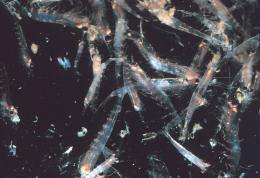October 13, 2009 weblog
Krill 'superswarm' formation investigated

(PhysOrg.com) -- Scientists have been studying how krill form into superswarms, which are among the largest gatherings of living creatures on Earth.
Juvenile krill (small crustaceans resembling shrimps) gather in their trillions in the Southern Oceans to form superswarms. In the Antarctic, for example, one species of krill (Euphausia superb) forms superswarms that stretch for tens of kilometers.
Until recently, no one has understood why or how they do it. So scientists with the British Antarctic Survey (BAS), led by Cambridge (UK) researcher Dr Geraint Tarling, decided to try and find out. The team used echo-sounding equipment to study over 4500 different swarms of krill in the Scotia Sea, a massive area that lies between South Georgia Island and the Antarctic Peninsula.
The report, published in the journal Deep Sea Research I, described how the research team discovered there are two types of swarm: small swarms composed of adult krill, and large swarms composed of juveniles.
The small swarms may be only around 50 meters long and four meters deep, and are not densely packed (about 10 krill per cubic meter). The large swarms are the "superswarms", which can stretch for many kilometers and are about 30 meters deep. The superswarms are much denser, with up to 10 times more individual krill per cubic meter.
This was the opposite of the result expected by Dr Tarling and his team, who thought the small swarms would be dense and the superswarms more diffuse. Dr Tarling said he was astonished at the density of the superswarms and the concentration into a small area of such a massive amount of biomass.
The BAS team also discovered that the large swarms tended to form when there was less food available, but the reasons for the formations of superswarms were unclear. Dr Tarling said a likely explanation is that a large swarm gives an individual protection from predators such as seals and whales, and a large swarm can confuse predators. It can also be more energy efficient, which could help juveniles grow more quickly.
The trade-off in forming large swarms is much greater competition for food, and this could explain why adult krill form less densely packed swarms, since they are more negatively buoyant than juveniles, and have to expend more energy in swimming. They need more food than the juveniles, and benefit from less competition.
Another finding of the research that was opposite to the expectation was that superswarms are more likely to occur at night. It was previously believed this would be less likely, since krill feed at night.
The habit of forming superswarms containing trillions of juveniles means that most of the young krill in the Antarctic Ocean are likely to be in just a few superswarms. This means krill may be much more susceptible to overfishing than thought previously since fishing fleets can locate and catch entire swarms. In doing so, they may be wiping out most of the krill in the Southern Oceans, and hence endangering everything else in the food chain that depends on them.
More information: Variability and predictability of Antarctic krill swarm structure, Geraint A. Tarling et al., Volume 56, Issue 11, November 2009, Pages 1994-2012, doi:10.1016/j.dsr.2009.07.004
© 2009 PhysOrg.com
















